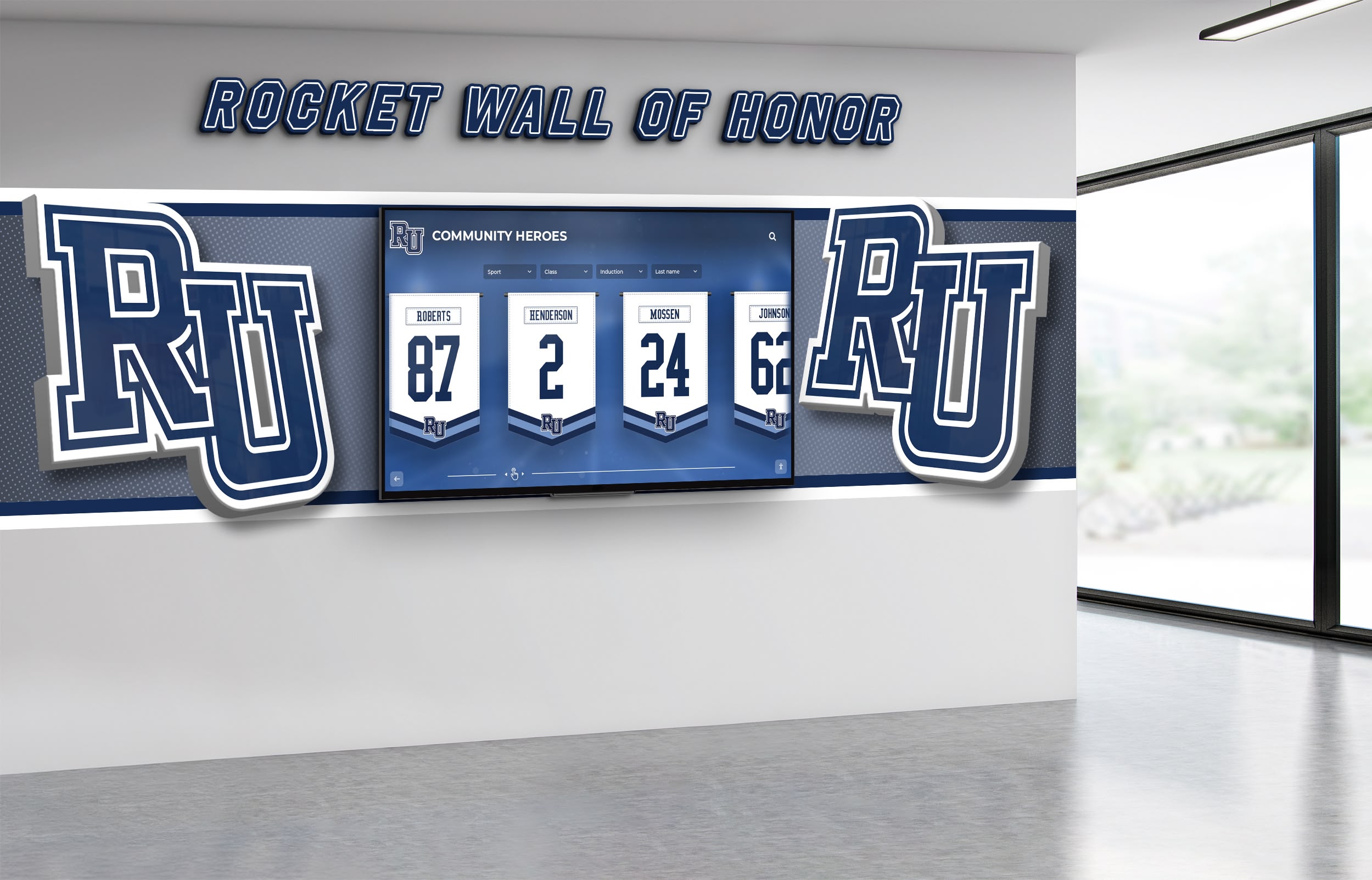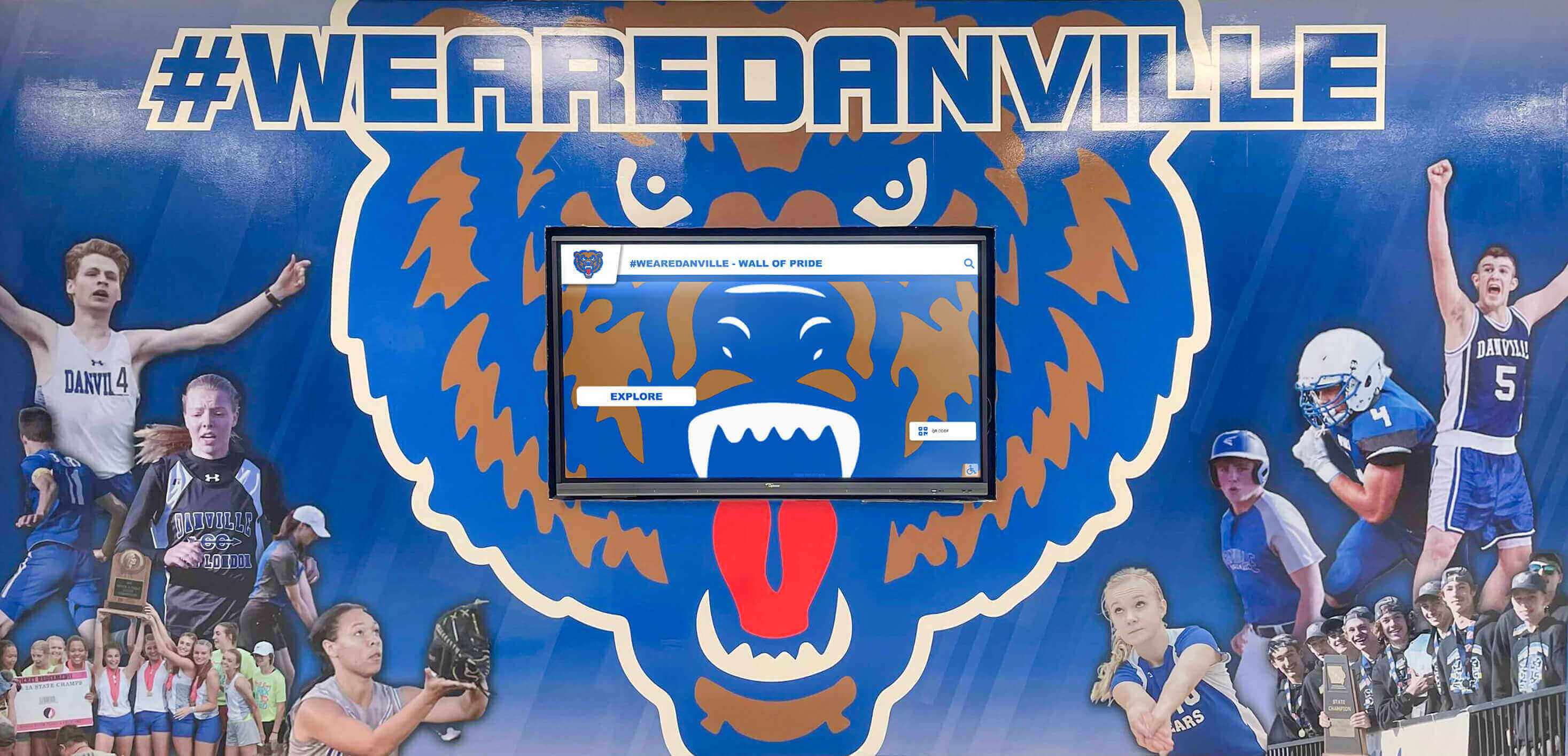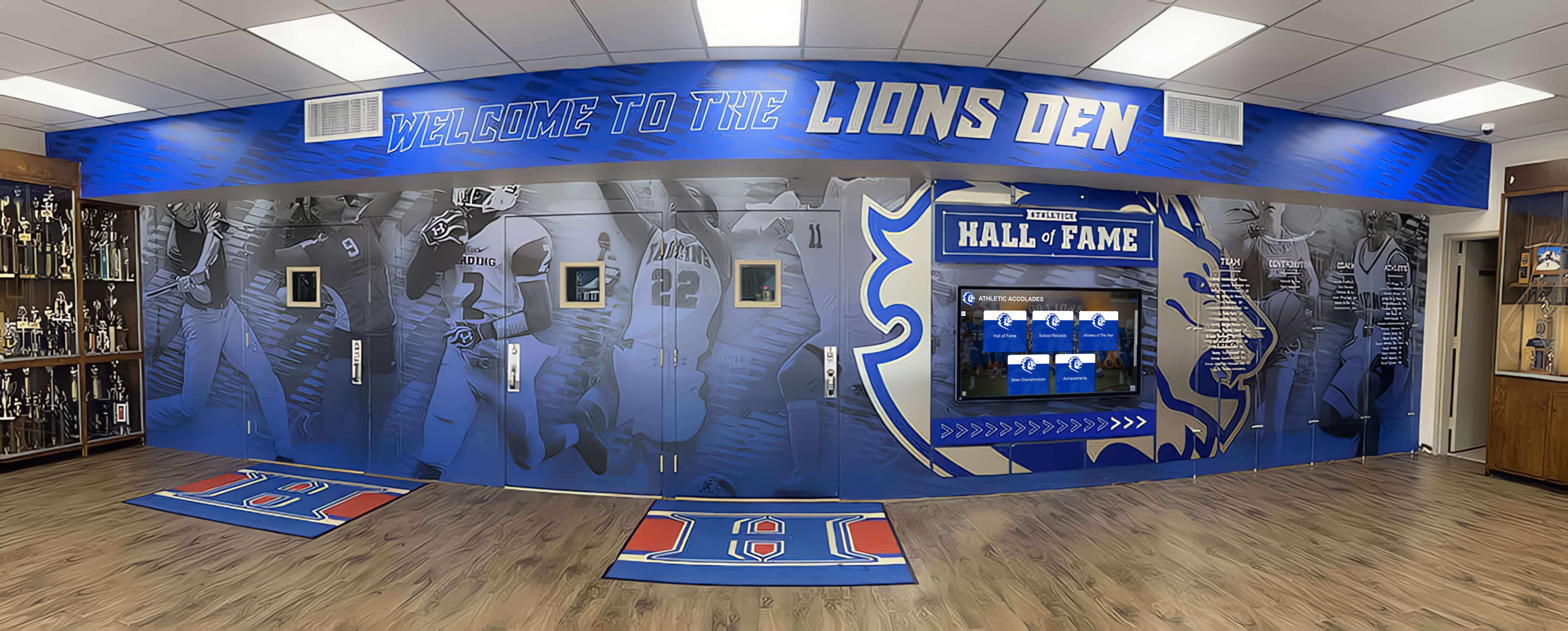An athletics wall of honor represents one of the most visible statements a school can make about what it values and celebrates. Unlike trophies stored in cases or banners hung high on gymnasium walls, a well-designed wall of honor places individual athletic achievement front and center—creating permanent recognition that inspires current athletes while preserving institutional history for future generations.
Yet many schools struggle with athletics wall of honor programs that fail to achieve their potential. Space constraints force difficult decisions about which athletes to recognize. Outdated displays communicate neglect rather than honor. Static plaques provide minimal information about achievements that deserve comprehensive storytelling. And maintenance challenges mean recognition programs that launched with enthusiasm gradually fade into forgotten corners of athletic facilities.
Modern approaches to athletics walls of honor solve these traditional limitations while amplifying the benefits these recognition programs can deliver. This comprehensive guide explores every dimension of creating impactful athletics recognition—from planning and selection criteria to modern digital solutions that transform how schools honor their student athletes.
Why Athletics Walls of Honor Matter for School Communities
An athletics wall of honor serves multiple strategic purposes beyond simply listing names. These recognition systems inspire current athletes by showcasing achievable pathways to excellence, strengthen school pride by celebrating institutional achievement traditions, preserve athletic program history that would otherwise fade from memory, engage alumni by maintaining visible connections to their accomplishments, and support recruiting by demonstrating program quality to prospective families. Modern digital recognition solutions like Rocket Alumni Solutions enable schools to create comprehensive walls of honor that accommodate unlimited athletes while providing rich storytelling capabilities impossible with traditional approaches.
Understanding Athletics Walls of Honor
Before exploring implementation strategies, understanding what makes athletics walls of honor effective helps schools design recognition programs that achieve intended goals.
The Purpose and Impact of Athletic Recognition
Athletics walls of honor fulfill distinct purposes within school communities that other forms of recognition cannot replicate. Unlike participation acknowledgment or season-ending awards, permanent walls of honor communicate that certain achievements merit lasting institutional commemoration.
Inspiration for Current Athletes: When student athletes see comprehensive recognition of peers and predecessors who achieved excellence, they gain concrete understanding of what’s possible. A freshman basketball player viewing former All-State selections understands exactly what level of performance earns lasting recognition. This visibility transforms abstract concepts like “athletic excellence” into tangible, achievable goals.

Historical Preservation: Athletic programs generate rich histories through championship seasons, record-breaking performances, and athletes who achieved remarkable success. Without systematic recognition, these achievements fade from institutional memory within a generation. Athletics walls of honor preserve this history, creating connections between current athletes and the traditions they’re part of.
Program Reputation and Recruiting: Prospective families evaluating schools pay attention to visible evidence of athletic program quality. A comprehensive wall of honor demonstrates depth of excellence and commitment to recognizing student achievement—messages that resonate with athletically talented students and their parents.
Alumni Engagement: Former athletes maintain strong emotional connections to athletic experiences that shaped their development. When schools visibly honor these contributions through permanent recognition, alumni feel valued and maintain engaged relationships with institutions that remember their achievements.
Resources on all-state athlete recognition explore specific strategies for honoring elite athletic achievement within comprehensive recognition programs.
Types of Athletics Walls of Honor
Schools implement athletics recognition in various formats, each offering distinct advantages depending on institutional context and objectives.
Comprehensive Athletic Achievement Walls: Some schools create walls honoring all significant athletic achievements across all sports—All-Conference selections, state championship team members, individual state qualifiers, school record holders, and athletes achieving major milestones. This inclusive approach celebrates breadth of excellence while ensuring recognition opportunities across all athletic programs.
Elite Achievement Recognition: Other schools limit walls of honor to highest achievements—All-State selections, state champions, athletes advancing to professional or high-level collegiate competition, and school hall of fame inductees. This selective approach maintains prestige through exclusivity while ensuring recognition carries significant meaning.

Sport-Specific Recognition: Some athletic programs maintain separate recognition for each sport, creating dedicated spaces in sport-specific facilities or designated areas. This approach allows sport-specific context and detailed achievement documentation while preventing cross-sport comparison challenges.
Multi-Dimensional Recognition Systems: Progressive schools combine multiple recognition levels—comprehensive digital systems accommodating all qualified athletes alongside selective physical displays featuring highest honors. This hybrid approach satisfies diverse stakeholder preferences while solving practical limitations through layered recognition.
Planning Your Athletics Wall of Honor
Successful recognition programs begin with comprehensive planning addressing selection criteria, location, format, and long-term sustainability.
Establishing Clear Selection Criteria
Credible athletics walls of honor require transparent, merit-based criteria that stakeholders understand and accept as fair. Vague standards or inconsistent application undermines recognition value and creates controversy.
Achievement Thresholds: Define specific accomplishments warranting recognition including All-State, All-Conference, All-Region designations, state championship participation or medals, school records in any event or statistical category, major milestone achievements (1000 points, 100 wins, etc.), and athletes advancing to Division I, professional, or Olympic competition.
Achievement thresholds should align with desired selectivity. Highly selective walls of honor recognizing only All-State athletes communicate elite exclusivity. More inclusive programs recognizing All-Conference selections or state qualifiers celebrate broader excellence while still maintaining meaningful standards.
Character and Conduct Standards: Beyond pure athletic achievement, most credible programs require exemplary character and conduct. This prevents recognition of athletes whose behavior might embarrass schools regardless of competitive accomplishments. Character standards should be clearly articulated and consistently applied.
Eligibility Requirements: Establish clear rules about eligibility including minimum participation requirements (full seasons, varsity letter, etc.), waiting periods between achievement and recognition if applicable, and continued good standing after graduation for programs recognizing alumni achievements.
Resources on student athlete recognition programs provide frameworks for developing comprehensive criteria that celebrate diverse contributions while maintaining credibility.

Location and Visibility Considerations
Recognition placement dramatically affects program impact. The best wall of honor content becomes invisible if located where students, families, and visitors rarely encounter it.
High-Traffic Athletic Locations: Ideal placements include main gymnasium entrances where all athletic events create natural traffic, primary athletic facility hallways connecting multiple sport spaces, weight rooms or training facilities where athletes spend significant time, and athletic department lobbies or central gathering spaces.
School-Wide Prominent Locations: Some schools place athletics walls of honor in main school entrances, creating visibility beyond athletic contexts. This approach celebrates athletic achievement as part of comprehensive institutional excellence while ensuring recognition reaches entire school communities.
Accessibility and Viewing Experience: Consider appropriate viewing heights accommodating diverse visitors, adequate lighting ensuring clear visibility without glare, sufficient space for comfortable viewing without crowding, and ADA compliance ensuring all community members can engage with recognition.
Strategic placement transforms walls of honor from overlooked displays into destinations where recognition actively shapes school culture and inspires athletic excellence.
Traditional vs. Digital Recognition Approaches
Schools face fundamental decisions about recognition format—traditional physical displays, modern digital systems, or hybrid approaches combining both.
Traditional Physical Displays using engraved plaques, mounted photos, and permanent installations offer tangible permanence, no technology dependencies, familiar aesthetic that many alumni prefer, and lower ongoing costs after initial installation. However, they face space limitations constraining recognition capacity, high per-athlete costs for plaques and installation, difficulty updating or correcting information, and minimal content depth beyond basic names and achievements.
Digital Interactive Systems using touchscreen displays and web platforms provide unlimited recognition capacity accommodating all qualified athletes, rich multimedia content including photos, videos, and comprehensive statistics, easy content updates without physical modifications, search and filtering capabilities helping visitors discover specific athletes, remote accessibility extending recognition beyond physical locations, and analytics revealing engagement patterns. However, they require higher initial technology investment, ongoing software and support costs, and technical expertise for implementation and maintenance.

Hybrid Recognition Strategies: Many successful programs combine selective traditional displays for highest-profile athletes with comprehensive digital systems accommodating unlimited recognition. This balanced approach honors traditionalist preferences while solving practical limitations through modern capabilities. QR codes on physical plaques can link to expanded digital profiles, creating seamless integration between physical and digital recognition.
Solutions like digital trophy displays demonstrate how modern technology transforms recognition from space-constrained physical displays into engaging interactive experiences.
Creating Compelling Recognition Content
Display format matters less than content quality. The most advanced technology fails if content doesn’t appropriately honor athletes or engage audiences.
Essential Profile Elements
Comprehensive athlete profiles transform simple name listings into meaningful recognition that celebrates complete achievements.
Biographical Information: Include athlete name and graduation year, sport(s) and position or events, hometown and background when appropriate, and academic honors demonstrating well-rounded excellence. This context helps audiences understand athletes as complete individuals rather than just statistics.
Athletic Achievements: Document specific accomplishments including All-State, All-Conference, or All-Region selections, state championship participation and placements, school records with relevant statistics, career statistics or milestone achievements, team captain or leadership roles, and post-high school athletic career (college commitment, professional opportunities).
Visual Content: High-quality photographs make recognition personal and engaging. Action shots showing athletes in competition create emotional connection while professional portraits provide formal dignity. When possible, include multiple photos documenting athletic careers across multiple seasons.
Contextual Narrative: Brief written narratives explain what made athletes special beyond bare statistics. Did they overcome adversity? Demonstrate exceptional leadership? Pioneer success in developing programs? These stories honor complete contributions while creating engaging content that generic lists cannot match.
Resources on creating engaging digital content provide strategies for developing compelling profiles that appropriately honor athletic achievement.

Gathering Historical Recognition Information
Many schools implementing athletics walls of honor discover that comprehensive historical records don’t exist in accessible formats, complicating efforts to create complete recognition.
Systematic Historical Research: Compile information through yearbook reviews documenting achievements and team rosters, newspaper archive searches capturing contemporary coverage, coach and administrator interviews preserving institutional memory, athlete and family outreach requesting information and materials, and state athletic association records where available.
Photo and Media Collection: Visual content proves particularly challenging for historical recognition. Sources include yearbook scanning and digitization, family photograph requests, local newspaper archive images, memorabilia documentation when original photos unavailable, and video footage from school or family archives when possible.
Accepting Incomplete Information: Historical recognition may lack statistical detail or photographic quality available for recent athletes. Rather than waiting for perfect information that may never materialize, schools should recognize athletes with available data while continuing research enabling future enhancements.
Implementing Digital Athletics Walls of Honor
Modern digital recognition platforms transform what’s possible while addressing traditional limitations that constrained physical displays.
Interactive Touchscreen Recognition Systems
Large touchscreen displays create engaging recognition experiences where visitors actively explore athlete profiles rather than passively viewing static plaques.
Unlimited Recognition Capacity: Digital platforms eliminate space constraints that plague traditional displays. Rather than limiting recognition to physically available wall space, digital systems accommodate comprehensive recognition of all deserving athletes without forced exclusions based on capacity limitations.
Rich Multimedia Storytelling: Video highlight packages showcase athletic excellence in ways static photos cannot match. Photo galleries document career progression from freshman seasons through senior achievements. Audio interviews where athletes reflect on experiences add personal dimensions. Digital platforms transform recognition from simple acknowledgment into comprehensive storytelling.

Search and Discovery Features: Interactive systems allow users to search by athlete name, graduation year, sport, or achievement type, facilitating personalized exploration. A parent researching your program can explore all state qualifiers in their child’s sport. An alumnus visiting can instantly find their own recognition from decades earlier. These discovery tools make massive recognition databases navigable and personally relevant.
Easy Content Management: Cloud-based platforms enable non-technical staff to update displays confidently from any location. Adding new athletes requires simply uploading content through web interfaces rather than requiring physical fabrication and installation. This update ease ensures recognition remains current without excessive administrative burden.
Solutions like interactive touchscreen recognition systems provide purpose-built platforms specifically designed for athletic recognition needs.
Online and Mobile Recognition Platforms
Digital recognition extends beyond physical installations through web-based platforms accessible worldwide.
Remote Accessibility: Online athletics recognition enables athletes, families, and community members to explore recognition from anywhere. An athlete at college can share their high school recognition profile with teammates. Grandparents living across the country can view grandchildren’s athletic honors. Journalists researching program history can access comprehensive information easily.
Social Media Integration: Web platforms facilitate easy sharing on social networks, amplifying recognition reach beyond school-controlled channels. When athletes earn All-State recognition, families share digital profiles across extended networks, multiplying visibility and celebrating achievement with distant friends and relatives.
Permanent Digital Archives: Online systems create searchable archives preserving recognition indefinitely. Even if physical facilities change or schools relocate, digital records remain accessible ensuring no athlete’s achievement gets lost to time or institutional transitions.
Video and Multimedia Integration
Professional athletes deserve recognition showcasing their abilities in action, not just statistical summaries. Video integration represents one of digital recognition’s most powerful advantages.
Comprehensive video libraries can document signature performances and memorable moments, career highlight packages condensing seasons into engaging summaries, championship moments capturing athletes at competitive peaks, and interview footage where athletes share perspectives on experiences. This multimedia content creates emotional engagement that statistics alone cannot achieve.

Sport-Specific Recognition Considerations
Different sports present unique recognition challenges and opportunities requiring tailored approaches within comprehensive programs.
Team Sport Recognition
Team sports like football, basketball, soccer, and volleyball generate recognition through individual achievement within team contexts. Walls of honor should acknowledge both—celebrating individual All-State performers while also recognizing championship teams that achieved collective excellence.
Balancing Individual and Team Recognition: Some athletes earn individual honors without team championship success. Conversely, championship teams include contributors who may not receive individual All-Conference or All-State recognition. Comprehensive walls of honor celebrate both dimensions appropriately.
Position-Specific Context: A linebacker’s 100 tackles carries different significance than a quarterback’s 2,000 passing yards, yet both may represent exceptional achievement in their positions. Recognition content should provide position-appropriate context helping audiences understand accomplishment magnitude.
Individual Sport Recognition
Sports like track and field, cross country, swimming, golf, tennis, and wrestling feature individual competition requiring different recognition approaches than team sports.
Event-Specific Recognition: Track athletes who excel in sprints, distance, jumps, or throws deserve event-appropriate recognition acknowledging different skill sets. Similarly, swimmers competing in freestyle, butterfly, breaststroke, or backstroke across various distances merit event-specific context.
State Meet and Championship Performance: Many individual sports center recognition around state meet placements and medals. Documentation should include specific events, times or distances, placing at state championships, and school records where applicable.
Resources on athletic record board displays explore approaches for documenting individual sport achievements within comprehensive recognition systems.

Equity and Inclusion in Athletic Recognition
Comprehensive athletics walls of honor should celebrate excellence across all programs rather than favoring high-visibility sports that already receive disproportionate attention.
Ensuring All-Sport Representation
Without intentional equity measures, recognition programs risk disproportionately featuring football and basketball athletes while marginalizing achievements in other sports.
Proportional Recognition: Track recognition distribution by sport relative to program size and season length. If wrestling, swimming, and tennis produce All-State athletes but receive minimal wall of honor visibility, examine whether selection processes or display design creates systematic bias favoring certain sports.
Visibility Equity: Even when all sports receive numerically appropriate recognition, display design may create visibility hierarchies. Ensure golf, cross country, and volleyball athletes receive prominent placement comparable to football and basketball performers rather than relegation to secondary locations or smaller formats.
Gender Equity Considerations
Federal Title IX requirements mandate equitable treatment of male and female athletic programs. While walls of honor typically fall outside direct Title IX athletics compliance, equity principles should inform recognition design.
Balanced Recognition: Ensure female athletes receive recognition opportunities proportional to their participation in athletic programs. If 45% of school athletes are female, female athlete representation in walls of honor should approximate this proportion.
Equal Prominence: Male and female athlete recognition should receive equivalent visibility, content quality, and update frequency. Avoid design approaches that create primary male recognition with secondary female recognition feeling like an afterthought.
Maintaining and Updating Recognition Programs
Successful athletics walls of honor require ongoing management ensuring displays remain current, accurate, and engaging.
Annual Update Processes
Systematic processes prevent recognition from becoming outdated and ensure newly qualified athletes receive timely acknowledgment.
End-of-Season Review Cycles: Establish predictable rhythms for identifying newly qualified athletes through coach nomination submissions documenting achievement, athletic director review verifying qualification against established criteria, selection committee approval for programs using committee processes, and athlete notification before public recognition announcements.
Content Development Workflows: Once athletes are selected for recognition, create efficient content development including photo collection and selection, biographical information gathering, achievement documentation and verification, profile writing maintaining consistent style and quality, and final review ensuring accuracy before publication.
Recognition Announcement: Publicly celebrate newly recognized athletes through school assembly or athletic department announcements, social media posts sharing achievements, website updates adding new profiles, newsletter features highlighting recent recognition, and recognition ceremonies when appropriate.

Addressing Errors and Updates
Even careful processes occasionally produce errors requiring correction or updates when additional information becomes available.
Digital recognition platforms enable quick error correction through simple content management updates. Traditional physical displays require ordering replacement plaques and scheduling reinstallation—expensive, time-consuming processes that often result in errors persisting indefinitely rather than prompt correction.
This update flexibility represents significant practical advantage for digital systems, ensuring recognition maintains accuracy and currency throughout program lifespans.
Recognition Ceremonies and Public Celebration
While permanent displays provide ongoing visibility, recognition ceremonies create special moments celebrating newly honored athletes.
Athletics Recognition Events
Dedicated recognition events focused specifically on athletics walls of honor create memorable experiences for athletes and families while generating community engagement.
Annual Induction Ceremonies: Some schools host annual ceremonies recognizing all athletes added to walls of honor during the preceding year. These events might include athlete recognition with families present, remarks from athletic directors or principals celebrating achievements, photo opportunities athletes and families treasure, and reception or social time building community connections.
Integration with Existing Events: Rather than separate ceremonies, some schools incorporate wall of honor recognition into existing activities like homecoming celebrations, athletic banquets, or senior recognition nights. This approach reduces logistical burden while ensuring good attendance through existing event draw.
Resources on senior day celebrations explore strategies for creating memorable recognition moments that honor athletic achievement appropriately.
Public Unveiling and Program Launches
When launching new athletics walls of honor or major display upgrades, public unveiling events generate awareness and excitement while demonstrating institutional commitment to athletic recognition.
Successful launches include prominent school and community leader participation signaling importance, comprehensive media coverage extending visibility beyond attendees, recognition of inaugural inductee classes or program founders, and tours or demonstrations helping stakeholders understand recognition features.
High-profile launches communicate that schools take athletic recognition seriously while creating initial engagement momentum supporting sustained program success.

Measuring Recognition Program Success
Effective programs evaluate performance systematically and adapt based on data and feedback ensuring ongoing relevance and impact.
Engagement and Visibility Metrics
For digital systems, analytics reveal recognition program reach and effectiveness. Track total interactions and viewing sessions, average time spent exploring content, most-viewed athlete profiles, search patterns showing discovery behaviors, and peak usage times indicating optimal announcement timing.
Physical displays can track estimated visitors through facility traffic patterns, photograph and social sharing frequency, community mentions and conversations, and qualitative observations of visitor engagement behaviors.
Stakeholder Satisfaction Assessment
Systematically gather perspectives from athletes about recognition program meaningfulness and pride in acknowledgment, coaches about program alignment with athletic department values, families about satisfaction with recognition approach and communication, alumni regarding maintained engagement and pride in historical recognition, and athletic department administrators about program sustainability and resource efficiency.
Regular feedback collection—annually or biennially—identifies improvement opportunities while validating program value through stakeholder voices.
Impact on Athletic Program Goals
Beyond direct recognition measures, assess whether walls of honor contribute to broader athletic program objectives including enhanced athlete recruitment and program participation, strengthened alumni engagement and giving, improved community perception of program quality, increased competitive success and achievement, and positive media coverage and public relations.
Resources on measuring digital recognition ROI provide frameworks for comprehensive evaluation demonstrating recognition program value.
Overcoming Common Implementation Challenges
Schools implementing athletics walls of honor encounter predictable obstacles that experienced approaches address effectively.
Limited Space Constraints
Traditional physical displays inevitably encounter space limitations as programs mature and recognition accumulates across decades.
Solutions for Space Limitations: Implement rotating displays periodically changing featured athletes, create tiered recognition with comprehensive digital systems complementing selective physical displays, expand recognition to multiple locations rather than single overcrowded space, or transition to digital platforms eliminating physical space constraints entirely.
Budget Constraints and Funding
Financial limitations affect many schools considering comprehensive athletics recognition programs.
Cost-Effective Approaches: Begin with phased implementation covering priority recognition populations first, seek alternative funding through athletic boosters, alumni donations, or memorial contributions, leverage existing technology infrastructure rather than purchasing dedicated systems, implement digital solutions offering lower long-term costs despite higher initial investment, and carefully plan to avoid expensive mistakes requiring correction.
Maintaining Historical Accuracy
Verifying historical athletic achievements from decades past proves challenging when official records are incomplete or unavailable.
Addressing Information Gaps: Conduct systematic research using available resources, transparently acknowledge documentation limitations where they exist, invite community assistance filling information gaps, and continue enhancing historical recognition as additional information emerges rather than waiting for perfect data before launching programs.

Future of Athletics Recognition
Athletic recognition continues evolving as technology advances and schools seek increasingly engaging approaches to celebrate achievement.
Emerging Recognition Technologies
Augmented reality technology enables smartphone or tablet users to scan physical displays and access enhanced digital content. Virtual reality could recreate memorable athletic performances, allowing future generations to experience historic moments. Artificial intelligence might automatically generate highlight packages or suggest recognition content based on statistical analysis.
Social and Interactive Recognition
Future systems will likely feature enhanced social connectivity allowing community members to contribute memories and congratulations, gamification elements making recognition exploration more engaging, and live integration connecting historical recognition with current athletic performance and achievements.
Personalized Recognition Experiences
Advanced systems may create personalized experiences based on visitor interests. Alumni might see recognition from their eras featured prominently. Prospective families could filter to specific sports of interest. Current athletes might receive suggestions for role models demonstrating similar positions or career paths.
Conclusion: Building Recognition Legacies That Inspire Excellence
Athletics walls of honor represent powerful institutional commitments to honoring student achievement, preserving program history, and inspiring future excellence. When thoughtfully designed and consistently maintained, recognition programs deliver lasting benefits extending far beyond simple acknowledgment of past accomplishment.
The most successful programs share common characteristics including clear, merit-based criteria ensuring fairness and credibility, comprehensive content appropriately honoring athlete achievements and contributions, strategic visibility ensuring recognition actively shapes school culture, equitable representation celebrating excellence across all athletic programs, and sustainable operations maintaining recognition quality and currency long-term.
Modern digital recognition solutions like those from Rocket Alumni Solutions enable schools to create athletics walls of honor that overcome traditional limitations while amplifying benefits. Unlimited capacity accommodates all deserving athletes without space constraints. Rich multimedia tells compelling stories honoring complete achievements appropriately. Easy updates eliminate expensive physical modifications maintaining current recognition. Remote accessibility extends engagement globally beyond physical campus visitors.
Whether schools choose traditional physical displays, cutting-edge interactive digital systems, or hybrid approaches combining both elements, core principles remain constant: transparent selection processes, professional presentation standards, comprehensive content development, sustained operational commitment, and continuous adaptation based on experience and feedback.
Athletics walls of honor honor the past, inspire the present, and shape the future—preserving excellence for those yet to come while demonstrating that extraordinary athletic achievement deserves permanent commemoration. The athletes you honor today become the inspiration for tomorrow’s excellence, creating cycles of achievement that strengthen athletic programs and communities across generations.
Schools ready to create or enhance athletics recognition can explore additional resources on military walls of honor, professional athlete recognition, and comprehensive hall of fame programs that maximize impact while creating manageable, sustainable recognition honoring student athletes for generations to come.


































